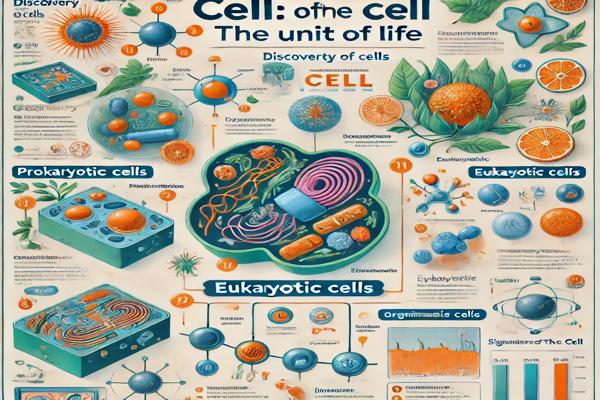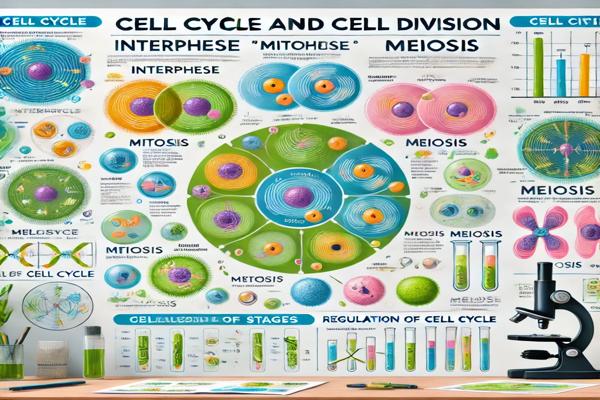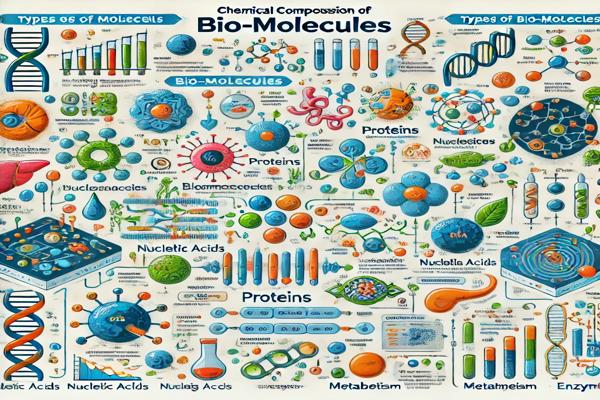Cell: The Unit of Life

Cells are the fundamental structural and functional units of all living organisms. Every organism, whether unicellular or multicellular, is made up of cells or aggregates of cells. The diversity in cell shape, size, and function reflects the wide range of activities performed by living organisms. Based on the presence or absence of a membrane-bound nucleus and organelles, cells can be classified as Prokaryotic or Eukaryotic.
Discovery of Cells
- Anton Von Leeuwenhoek: The first to observe and describe a live cell using a simple microscope. His observations laid the foundation for cell biology.
- Robert Brown: Discovered the nucleus, an essential organelle that acts as the control center of the cell.
- Cell Theory:
- Proposed by Matthias Schleiden and Theodor Schwann.
- Expanded by Rudolf Virchow, who added the critical principle: “All cells arise from pre-existing cells.”
- Fundamental principles:
- All living organisms are composed of cells and their products.
- Cells are the basic units of life.
- Cells arise from pre-existing cells.
Prokaryotic Cells
Prokaryotic cells are simpler in structure and function, typically found in bacteria, blue-green algae, mycoplasma, and PPLPs (Pleuro Pneumonia Like Organisms).
Structural Features
- Glycocalyx, Cell Wall, and Plasma Membrane:
- The glycocalyx is the outermost layer, providing protection and aiding in adherence to surfaces.
- The cell wall offers rigidity and shape. In bacteria, it is made of peptidoglycan.
- The plasma membrane is selectively permeable, maintaining homeostasis.
- Classification:
- Gram-positive bacteria: Retain crystal violet dye during Gram staining.
- Gram-negative bacteria: Do not retain the dye, appearing pink due to safranin counterstaining.
- Mesosome:
- Infoldings of the plasma membrane involved in respiration, secretion, and DNA replication.
- Flagella:
- Composed of three parts: filament, hook, and basal body. These structures aid in motility.
- Pili and Fimbriae:
- Surface structures aiding in attachment. Unlike flagella, they do not assist in motility.
- Ribosomes:
- Small (70S type) and composed of two subunits (50S and 30S). They are the sites of protein synthesis.
- Inclusion Bodies:
- Reserve materials such as phosphate granules, glycogen granules, and gas vacuoles.
Eukaryotic Cells
Eukaryotic cells are more complex and contain membrane-bound organelles. They are found in protists, fungi, plants, and animals.
Cell Membrane
The fluid mosaic model, proposed by Singer and Nicholson (1972), describes the membrane as a dynamic bilipid layer of phospholipids with embedded proteins, cholesterol, glycolipids, and glycoproteins. This structure allows selective permeability, communication, and transport.
Cell Wall
- Found in plants, fungi, and some protists.
- Composed of cellulose, hemicellulose, and pectin (in plants) or chitin (in fungi).
- Layers:
- Primary Cell Wall: Thin and elastic, present in young cells.
- Secondary Cell Wall: Thicker and rigid, providing mechanical support.
- Middle Lamella: Rich in calcium pectate, binding adjacent cells.
- Plasmodesmata: Cytoplasmic channels that connect neighboring cells.
Organelles in Eukaryotic Cells
- Endoplasmic Reticulum (ER):
- Smooth ER (SER): Synthesizes lipids and steroids; detoxifies harmful substances.
- Rough ER (RER): Studded with ribosomes, involved in protein synthesis and transport.
- Golgi Apparatus:
- Discovered by Camillo Golgi.
- Modifies, packages, and transports materials like glycoproteins and glycolipids.
- Lysosomes:
- Membrane-bound vesicles containing hydrolytic enzymes for intracellular digestion.
- Play a crucial role in autophagy and programmed cell death (apoptosis).
- Vacuoles:
- Bound by the tonoplast (vacuolar membrane).
- Store nutrients, excrete waste, and maintain cell turgor.
- Mitochondria:
- Known as the “powerhouse of the cell.”
- Sites of aerobic respiration, producing ATP.
- Double-membrane structure with cristae to increase surface area for enzymatic activity.
- Plastids:
- Found in plants and some protists.
- Types:
- Chloroplasts: Contain chlorophyll; sites of photosynthesis.
- Chromoplasts: Contain pigments for coloration.
- Leucoplasts: Store nutrients (amyloplasts for starch, elaioplasts for oils, aleuroplasts for proteins).
- Ribosomes:
- Discovered by George Palade.
- Larger (80S type) in eukaryotes, composed of 60S and 40S subunits.
- Function as the site of protein synthesis.
- Cytoskeleton:
- Composed of microtubules, intermediate filaments, and microfilaments.
- Provides mechanical support, motility, and shape maintenance.
- Cilia and Flagella:
- Core structure (axoneme) consists of a 9+2 arrangement of microtubules.
- Basal bodies anchor these structures.
- Centrosome and Centrioles:
- Contain two centrioles with a cartwheel structure.
- Organize microtubules and aid in spindle formation during cell division.
- Nucleus:
- Discovered by Robert Brown (1831).
- Components:
- Chromatin: DNA-protein complex, organized into chromosomes.
- Nucleolus: Synthesizes ribosomal RNA (rRNA).
- Nuclear Envelope: Double membrane with nuclear pores for transport.
- Chromosomes: Classified based on centromere position:
- Metacentric
- Sub-metacentric
- Acrocentric
- Telocentric
- Microbodies:
- Minute vesicles containing enzymes.
- Play roles in photorespiration, lipid metabolism, and detoxification.
Significance of the Cell
- Structural Basis: Cells provide structure and shape to organisms.
- Functional Units: All physiological processes occur within cells.
- Genetic Material: DNA in the nucleus (eukaryotes) or nucleoid (prokaryotes) governs inheritance and cellular activities.
- Energy Production: Mitochondria generate ATP, powering cellular functions.
- Specialization: In multicellular organisms, cells specialize into tissues, organs, and systems.
Conclusion
The cell is aptly called the “Unit of Life” as it forms the foundation of all biological processes. By studying cells and their components, we unlock the mysteries of life at its most fundamental level. Understanding cellular structures and functions not only explains how life is sustained but also provides insights into health, disease, and evolution.
Keywords: Cell: The Unit of Life, Prokaryotic Cell, Eukaryotic Cell, Organelles, Cell Theory, Nucleus, Mitochondria, Ribosomes, Cell Membrane, Cytoskeleton, Photosynthesis, Cellular Respiration.
Read also-
- NCERT Official Textbook
- CellThe Unit of Life – BYJU’S
- Cell: The Unit of Life – Toppr
- NCERT Solutions – Learn CBSE
- Cell: The Unit of Life – Vedantu
- ExamFear Notes
- https://alisciences.com/the-plant-kingdom-a-comprehensive-overview/
- https://alisciences.com/general-characteristics-of-animal-societies/
Hi, I’m Hamid Ali, an MSc in Biotechnology and a passionate Lecturer of Biology with over 11 years of teaching experience. I have dedicated my career to making complex biological concepts accessible and engaging for students and readers alike.
Beyond the classroom, I’m an avid blogger, sharing insights, educational resources, and my love for science to inspire lifelong learning. When I’m not teaching or writing, I enjoy exploring new advancements in biotechnology and contributing to meaningful discussions in the scientific community.
Thank you for visiting my blog! Feel free to connect and explore more of my work.





